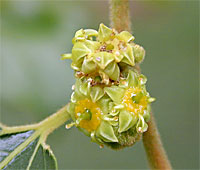View crop
View crop Data sheet EcoPortZiziphus mucronata
 |
|
| Notes |
|---|
| DESCRIPTION: It is usually a deciduous shrub or medium-sized tree up to 9 m tall with a trunk that is frequently crooked; branches spreading, often drooping, branching well above ground or near the base. Leaves ovate to broadly ovate, 2.5-8 x 1.9-8 cm, shiny, densely hairy to quite smooth. Fruit a round, reddish-brown, glossy drupe. Trees with 2 types of fruit, the small type 7-10 mm in diameter and the large type 15-25 mm in diameter, all often remaining on the tree after the leaves have fallen. USE: The fruit is eaten fresh or dried, in meal or porridge. The young leaves can be cooked and eaten as spinach. Seeds are roasted, crushed and used as a coffee substitute. Both leaves and fruits are browsed and used as fodder. The flowers are a source of honey. The wood is hard and makes good firewood and charcoal. The bark contains 12-15% tannin. Roots are used as a remedy for pain and to treat snakebite. Boils and other skin infections are treated with leaf paste, and this, together with an infusion of the roots, is a treatment for tubercular gland swellings, measles, dysentery, lumbago and chest complaints. The bark is used as an emetic; bark decoction is used for rheumatism and stomach troubles, bark infusion is used to treat coughs, and bark is used in a steam bath to purify the complexion. It is planted as a living fence. GROWING PERIOD: Perennial. COMMON NAMES: Cape thorn. FURTHER INF: It grows in areas dominated by thorny vegetation in both temperate and tropical climates. Also found in open scrubland, woodland, forest margins and riverine vegetation. It is a very hardy species, most common in dry areas; it is resistant to both frost and drought. Tolerant to shallow soils, seasonal waterlogging, salt spray and soil salinity. Regarded as an indicator of underground water. | Sources |
| SOURCE: ICRAF Agroforestree Database (22.07.02) E11001 |